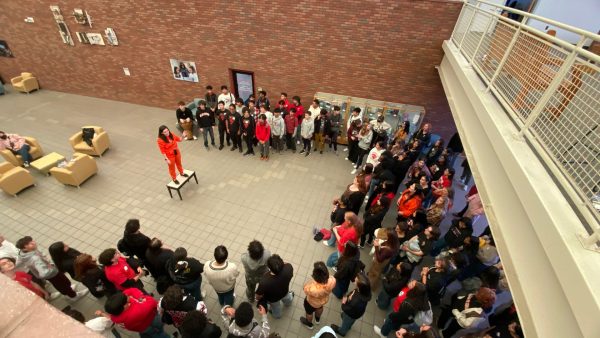A quiet, normal Thursday on the William Paterson University campus. Nothing could particularly and spontaneously happen, right? That was until the angelic high notes and harmonization of a large group of students flooded the Student Center and captured everyone’s attention.
From 1:10 p.m. to 1:50 p.m., a total of 110 North Jersey high school students from North Bergen, Bergenfield, Fairlawn, and Pascack Hills joined with 30 William Paterson choir students to deliver a song of freedom during a time of hopelessness. Hannah Carr, the William Paterson Choir Director, hosted a group of students singing and moving throughout campus, hoping to spread the message of freedom by singing “Shosholoza”, a South African freedom song that is made up of a combination of different African tribe languages. The song translates to “go forward,” as Carr explains that it has historical meaning to the singer(s) who created it.
Carr and her group began their musical journey in the Student Center in front of the Starbucks. The four students from different high schools gathered together in a circle, surrounding Carr as she mounted herself up on an empty table and began to clap in a song-like manner. The students quickly followed as a way to draw their attention to her. After introducing herself, the students, and their plan to bystanders and people passing the event, Carr slowly began to make hand and arm gestures as the building fell silent. Everyone was watching, waiting for what was to come. In a split second, beautiful voices from different groups of the high school choir students began to rise in the air, causing everyone’s attention to shift to Carr and the choir students. They began to sing in different tones in harmony – altos, sopranos, baritones, for instance. Each group with different cues, parts, and lyrics, but all were brought together for one reason.
An art major student, who asked to remain anonymous for personal reasons, was doing homework and studying in the gray chairs across the Multi-Purpose Room, swamped by her studies and assignments, when she suddenly heard this heavenly sound echoing through the Student Center, and when she looked up, she saw Carr and her choir students gathered around and singing, and she momentarily stopped what she was doing.
“It was like a break from all the work and classes, you know?” She stated. “They sounded absolutely beautiful.”
The performance at the Student Center lasted a total of 15 minutes before Carr guided the groups of high schoolers out of the building, down the pavement paths and stairs that led to University Hall. Once they entered the building, they repeated the same ritual – close together, surrounding Carr as she stood on a table in the midst of them before she raised her hands and arms to cue each group when to start singing, and when to come in for harmonization. Students sitting at tables, sitting in the couches nearby, and even the workers at Einstein’s Bagels, all quieted down and listened – some being completely silent, others recording, paying close attention to the harmonies, smooth whistling notes, clapping, and unity. This performance only took about 20 more minutes before Carr began to guide all the students out of the building, praising them and encouraging them as all 140 people marched up the stairs into the Atrium.

There in the Atrium, Carr, once again, hopped on top of a table and firmly asked for everyone’s attention. Students in seats and workers in the offices on the second floor slowly came out of their comfortable workplaces to see what was happening below. And behold, Carr and all her students were gathered around, laughing with one another as Carr lifted her hands and attempted to get their attention to begin. Everyone was silent and respectful of this performance, nodding their heads in approval as students harmonized, sang, whistled, and a young man beside Carr drummed along with the song in melody on a conga. As soon as it was over, all the bystanders started clapping and praising Carr and the students before they all dismissed themselves and started to head outside of the building and into school buses, leaving all the students/faculty standing stunned and refreshed with music and the message of freedom.
But why go from building to building to spread this?
“The building-to-building [method] was so people could hear us,” Carr stated. “Because otherwise, you know, we can invite people, but it’s just more powerful if we go to the places that we know people will be.”
On top of this new experiment of not staying in one place for a single performance, Carr decided to think outside the box and revealed that there was actually no practice of the song beforehand.
“I just taught everything to them today because I didn’t want them coming with having to – I think they’re less likely to come if they have to do prep beforehand, so I said, ‘It’s paperless singing. Don’t do nothing, just come with a water bottle.’ And so, we didn’t do anything.”
Carr also stated a hint of more to come, and to keep a lookout, and spread the word. Truly, many things happen on campus, but nobody would’ve suspected a large group of 140 people to bring such a meaningful message through their voices and intentions.